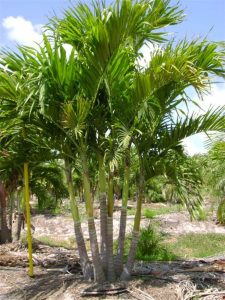Adonidia Palm Tree
Adonidia, or the Christmas palm, is a striking tree suitable for small landscaping projects. One of the main benefits of this plant is that it is low-maintenance. In addition, this tree is completely pest-free. Some of our clients at Palmco often confuse Adonidia with the Royal Palm because both have long fronds and green crowns.
 Palmco is a family-owned business located on more than 600 acres on gorgeous Pine Island. Our four generations of growing experience make it obvious why we are home to the one of the largest palm plantations in the nation.
Palmco is a family-owned business located on more than 600 acres on gorgeous Pine Island. Our four generations of growing experience make it obvious why we are home to the one of the largest palm plantations in the nation.
Our palms are hand-selected by our dedicated service team. We guarantee that they will arrive to you on time and in pristine, ready to plant condition. We work very hard at treating our customers right so that your clients are happy with you!
Low Maintenance
Adonidia is a low-maintenance plant because it does not require regular pruning. Once the fronds of the plant age or dry up, they drop off on their own, a huge maintenance plus. In addition, they are not prone to pest infection. Another significant feature of the Adonidia is that it does not overgrow to overwhelm a landscape.
The Adonidia palm makes an excellent focal point in any landscape and is suitable for small landscaping projects. Once the palm grows taller, it assumes an elegant look.
The Christmas Palm
The main reason Adonidia is also called the Christmas Palm is that it produces white flower blooms that mature into red berries right around Christmas. This plant grows well in USDA zones 10B-11, with mild winters and hot summers. It does not tolerate cold very well and may die off when exposed to prolonged cold weather.
Adonidia is a slow grower reaching heights of up to 15 feet. In addition, this plant is mildly tolerant to saline conditions and won’t be affected by the occasional salt spray in Florida.
One of the biggest concerns for this plant is cold weather. Many landscape architects in Florida grow the plant without being too concerned about the weather because Florida has excellent conditions for Adonidia growth. However, commercial landscapers in the North have to consider exposure to the cold when including Adonidia in their projects.
Plant Care
Adonidia grows exceptionally well in full sun or partial shade. However, excessive shade causes the plant’s trunks and fronds to thin. To promote growth, landscape architects often add organic peat to holes when planting Adonidia. In addition, they add fertilizer at least once during spring, summer, and autumn.
Landscape architects and commercial developers usually allow the plant to shed off its brown fronds on its own instead of pruning. However, some landscape architects who cannot stand the look of brown fronds on a tree cut them off. It is beneficial to leave the fronds to fall off on their own because it adds nutrients to the soil, promoting new fronds’ growth.
Plant Spacing
We recommend planting single trunk Adonidias in tight groups at least 5 feet away from each other. This spacing offers Adonidias adequate space to grow Some landscape architects position the trunks of multi-trunk Adonidias appropriately to not stand in the way once they grow bigger.
Like other palm trees, Adonidia helps reduce the effects of global warming by reducing the effects of aerosol emissions on the environment. Unlike other plants, the Adonidia palm emits low levels of organic chemicals. At Palmco, we understand the effects of plant growth on the environment, so we have incorporated environmentally friendly practices in our plantation management.
Are you looking for an Adonidia Palm tree for your landscaping project? Contact Palmco today to order. Our bamboo, palm, and mast trees are grown on a huge plantation in Bokeelia, FL, with minimal effects on environmental resources, including water.

